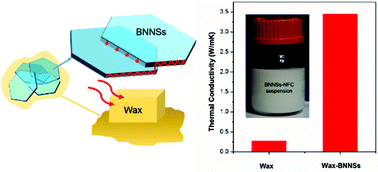Thermally conductive, dielectric PCM–boron nitride nanosheet composites for efficient electronic system thermal management
Abstract
Phase change materials (PCMs) possessing ideal properties, such as superior mass specific heat of fusion, low cost, light weight, excellent thermal stability as well as isothermal phase change behavior, have drawn considerable attention for thermal management systems. Currently, the low thermal conductivity of PCMs (usually less than 1 W mK−1) greatly limits their heat dissipation performance in thermal management applications. Hexagonal boron nitride (h-BN) is a two-dimensional material known for its excellent thermally conductive and electrically insulating properties, which make it a promising candidate to be used in electronic systems for thermal management. In this work, a composite, consisting of h-BN nanosheets (BNNSs) and commercialized paraffin wax was developed, which inherits high thermally conductive and electrically insulating properties from BNNSs and substantial heat of fusion from paraffin wax. With the help of BNNSs, the thermal conductivity of wax–BNNS composites reaches 3.47 W mK−1, which exhibits a 12-time enhancement compared to that of pristine wax (0.29 W mK−1). Moreover, an 11.3–13.3 MV m−1 breakdown voltage of wax–BNNS composites was achieved, which shows further improved electrical insulating properties. Simultaneously enhanced thermally conductive and electrically insulating properties of wax–BNNS composites demonstrate their promising application for thermal management in electronic systems.



 Please wait while we load your content...
Please wait while we load your content...